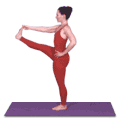To begin your practice, stand with your weight evenly balanced on both feet and the crown of your head floating toward the ceiling. (If you think your balance might be shaky, you may want to stand with your left shoulder a foot or so from a wall,
 so you can reach out and steady yourself with your left hand if necessary.) [Figure 1] Take a moment to explore your balance in this simple standing pose. Is your weight evenly distributed between the right and left foot? Between the ball of the foot and the heel? Spread the toes and actively draw the kneecaps upward to firm the legs.
so you can reach out and steady yourself with your left hand if necessary.) [Figure 1] Take a moment to explore your balance in this simple standing pose. Is your weight evenly distributed between the right and left foot? Between the ball of the foot and the heel? Spread the toes and actively draw the kneecaps upward to firm the legs.On an exhalation, keeping the spine long, bend the right knee toward your chest and hook the right big toe with the first two fingers of your right hand. Rest the left hand on your left hip and balance
 on one leg for five to 10 long breaths. [Figure 2] Going this far might be challenge enough! Rest your eyes softly but steadily on a single point to help establish and maintain your balance.
on one leg for five to 10 long breaths. [Figure 2] Going this far might be challenge enough! Rest your eyes softly but steadily on a single point to help establish and maintain your balance.If you want to go further, slowly begin to straighten the right leg, keeping hold of the big toe with your fingers. [Figure 3]
 Let the pose unfold from your core, unfurling your leg like a flower blossoming out of your belly. Keep the left leg strong and straight. Resist the impulse to hunch forward over the lifted leg. Instead, keep the spine reaching toward the sky. Continue to drop the right hip down so the hips remain square and level with each other.
Let the pose unfold from your core, unfurling your leg like a flower blossoming out of your belly. Keep the left leg strong and straight. Resist the impulse to hunch forward over the lifted leg. Instead, keep the spine reaching toward the sky. Continue to drop the right hip down so the hips remain square and level with each other.Stay in this pose for five more breaths. Let your brain relax. Tensing your muscles, holding your breath, and tightening your jaw and belly will only make things more difficult.

